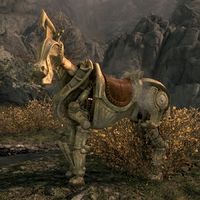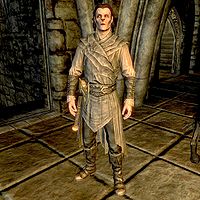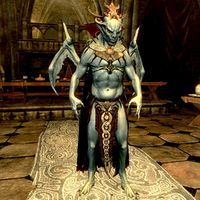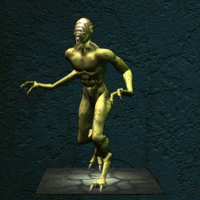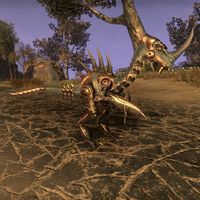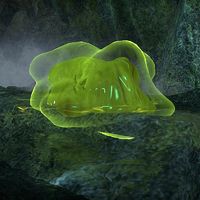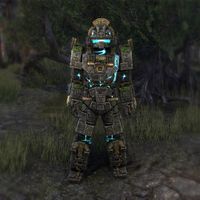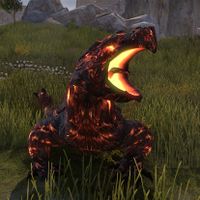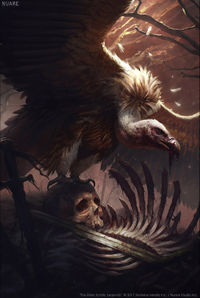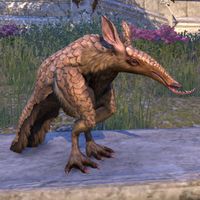Lore:Bestiary V
Vamidium[edit]
Vamidium is the Dwemeris word for "mount". It is used to refer to the many different types of animunculi constructed by the Dwemer for use as steam-powered mechanical mounts. Many of these constructs were made to imitate nature, taking the form of animals commonly used as mounts by the other races of Tamriel. Like other animunculi, vamidiums appear to utilize soul gems or dynamo cores as a power source.
Vampire[edit]
A vampire is a preternatural being, commonly believed to be a reanimated corpse, which consumes the blood of living creatures. The vampires of Tamriel are undead, diseased persons who are hated, hunted, and misunderstood by the living. Whether they consider themselves cursed or blessed, or whether they have given into their animalistic instincts or have sought to rid the world of the disease, vampires are nonetheless considered abominations.
Vampire Lord[edit]
The Vampire Lord is a powerful type of vampire, being much closer to being pure-blooded, although they do not necessarily have to be. Vampire Lords are tall humanoid bat-like creatures with sharp, sometimes poisonous talons and small wings. These creatures can shift between their original forms and the Vampire Lord form at will. They are also capable of using magic, and can also transform themselves into a cloud of bats to pass small distances or even mist to become temporarily invincible.
- Skyrim(DG), ESO, Legends, Call to Arms
Velk[edit]
Velks are a long-legged species native to Morrowind. They are only very rarely found outside of their home province, due to them requiring a large amount of kresh-weed in their diet.[1]
- See also: Sand Kwoom
Vermai[edit]
Vermai are a type of gaunt and sharp-toothed Daedra that serve as dark minions of the lesser Daedra lords. They are aggressive and mindless, and typically attack all who approach. It is said that the Vermai have no thoughts, and therefore cannot fear. They have sometimes responded to attempts at communication, but never in any intelligible way, considered to be one of the most idiotic Daedra.
Those who summon them can control them through pacifying helmets. At some point during the early Second Era, the prodigal student Faindor of Agea Relle summoned Vermai through alchemy to serve him; out of spite, Nerien'eth had those same Daedra torture him. N'Gasta, a servant of Clavicus Vile, summoned Vermai to guard his tower and kept them under control through helmets. The "Vermai Clan" served Zenaida Nacarra, aiding Mehrunes Dagon in his invasion of the Battlespire during the Imperial Simulacrum.
Verminous[edit]
The Verminous are bipedal reptilian beasts that were once common across Velothi lands, but went extinct long before the Second Era. Sotha Sil created Verminous Fabricants, artificial imitations that bore the name of the Verminous, to preserve part of the past and serve as a reminder of things that once were. The original Verminous were perceived as a "small", as in relatively unnoteworthy species. Knowledge of the Verminous had long faded from public consciousness following their extinction, as the residents of modern-day Mournhold and even some residents of the Clockwork City were unfamiliar with the species the fabricants were based on.
Verminous Fabricant[edit]
Verminous Fabricants are Fabricants created by Sotha Sil that resemble lean bipedal reptiles. They have long necks, long tails, a horn on their noses, and various metallic limbs and spikes, which they utilize to attack their prey. Sotha Sil created them as imitations of extinct creatures of the same name that once roamed across Velothi lands, to serve as a reminder of a thing that once was. He sought to perfect them (in his eyes) with an amalgam of flesh and metal. Aside from being quick, agile, and being able to fit into small spaces, they also are capable of spinning into their target, generating shockwaves, and as a last resort, self-destructing. They are powered by an animo core, and can be contained within fabrication tanks. Verminous Fabricants dwell in Clockwork City, but have in occasion made it to Tamriel.
Vireo[edit]
Vireos are a type of bird. A type of dye was named after Violet-Crowned Vireos.[2]
Vole[edit]
Voles are a type of unpleasant rodent.[3][4] In an probable case of miscommunication, the Duke of Crows of the Blackfeather Court once insulted one of his servants by saying they didn't have the brains of an inbred vole, after said servant had brought him the brains of twenty voles.[5]
Voriplasm[edit]
A Voriplasm (a.k.a. an Ooze or Slime) is an amorphous blob of sentient green mucus, mostly found in Black Marsh. Known for having an insatiable hunger, these creatures can strip down their victims to the bone within moments, or can form spikes to pierce their target. Voriplasms can then envelop and puppeteer the remaining skeletal structure of their victims as a "voriplasmic corpse". The word for their name in Jel is unknown, but it translates to "death-mud".
It is believed that their ability to split into smaller entities is how these slimes reproduce. One Argonian theorizes that perhaps all voriplasms originate from one singular "mother-beast". Leading credence to this theory is the "Wuju-Ka", a gargantuan slime that was sealed away in Tsofeer Caverns in Murkmire. This Wuju-Ka was essentially a spawning pool, churning out smaller versions of itself, and had a higher degree of control over them than the common voriplasm. Indeed, it utilized them as its "eyes, ears, and appendages", and through these extensions is how it interacted with the world outside its containment.
Voriplasms are considered highly metamorphic and are able to adapt to their surroundings with unbelievable specificity. Voriplasms, or at least organisms very similar to them, seem to be capable of forming from unclean locations or diseased creatures, even outside of Black Marsh.
- Variations: Bile Glob, Giant Voriplasm, Monstrous Ooze, Peryite's Glory, Riven Ooze, Spattering Ooze, Swamp Rot
Voskrona Guardian[edit]
Voskrona Guardians (Voskrona roughly translating to Stone Colossal in Jel)[6][7] are ancient Argonian constructs that served as a temple guardians. It is possible to mystically assume the form of a Voskrona Guardian with the aid of magic.[8]
Vulk'esh[edit]
Vulk'esh are creatures of fire and lava that can be found all across High Isle and Amenos. Little is understood about them or their origins. They are known to live in underground volcanic depths, swimming through seas of fire.[9]
It is speculated Vulk'esh eat minerals, but there is no actual evidence for this.[9] Despite their strange morphology, they lay eggs to proliferate. The cooled molten crust of these creatures is known as "Vulk'esh Scoria", and it is believed to have magical properties.[10] Their excrement has a tendency to harden into dense, heavy, igneous coprolites.[11] Ash Hoppers can often be found in their wake.
Vulture[edit]
Vultures are scavenger birds that live in arid regions and feed on carrion. Terror Birds are described as bearing resemblance to them.[12]
- See also: Buzzard
Vvardvark[edit]
Vvardvarks are primarily small creatures found in the province of Morrowind that were the result of a failed experiment by the Telvanni magister Varkenel in the Second Era. They are a magical hybrid that possesses scales, fur, and a long tongue, with their diet consisting of small insects. They are popular pets, and some Vvardvarks are even large enough to act as pack animals or riding mounts.
They were prevalent on the island of Vvardenfell, but by the late Third Era, the Vvardvarks found on Vvardenfell were wiped out by the Ash Blight phenomenon. Though due to be being imported elsewhere, they were also widespread on the mainland, notably in the Telvanni Peninsula.
References[edit]
- ^ People of Morrowind — Various
- ^ Fledgling: Violet-Crowned Vireo dye in ESO
- ^ A Life Barbaric and Brutal — Arthenice Belloq
- ^ Rulings text in Castles
- ^ Squire Caw's dialogue in ESO
- ^ Jaxsik-Orrn's dialogue in ESO: Murkmire
- ^ The Sharper Tongue: A Jel Primer — Lights-the-Way, Mystic of the Mages Guild
- ^ Voskrona Guardian polymorph appearance and description in ESO
- ^ a b Notes on Vulk'esh — Tarrinore
- ^ Vinilsare's dialogue in ESO: High Isle
- ^ Igneous Coprolite item description in ESO: High Isle
- ^ Anequina Animal Identification and Tasting — Hrodkir Mincemeat
